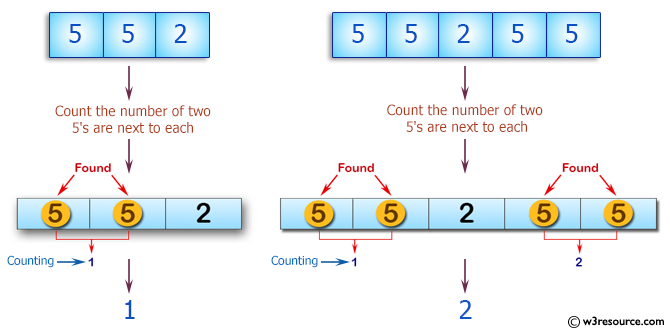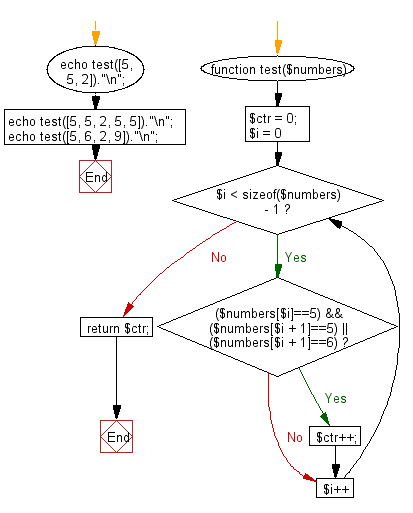PHP Exercises: Count the number of two 5's are next to each other in an array of integers
PHP Basic Algorithm: Exercise-37 with Solution
Write a PHP program to count the number of two 5's are next to each other in an array of integers. Also count the situation where the second 5 is actually a 6.
Sample Solution:
PHP Code :
<?php
function test($numbers)
{
$ctr = 0;
for ($i = 0; $i < sizeof($numbers) - 1; $i++)
{
if (($numbers[$i]==5) && ($numbers[$i + 1]==5) || ($numbers[$i + 1]==6)) $ctr++;
}
return $ctr;
}
echo test([5, 5, 2])."\n";
echo test([5, 5, 2, 5, 5])."\n";
echo test([5, 6, 2, 9])."\n";
Sample Output:
1 2 1
Pictorial Presentation:

Flowchart:

PHP Code Editor:
Contribute your code and comments through Disqus.
Previous: Write a PHP program to create a new string of the characters at indexes 0,1,4,5,8,9 ... from a given string.
Next: Write a PHP program to check if a triple is presents in an array of integers or not. If a value appears three times in a row in an array it is called a triple.
What is the difficulty level of this exercise?
Test your Programming skills with w3resource's quiz.
PHP: Tips of the Day
How to Sort Multi-dimensional Array by Value?
Try a usort, If you are still on PHP 5.2 or earlier, you'll have to define a sorting function first:
Example:
function sortByOrder($a, $b) {
return $a['order'] - $b['order'];
}
usort($myArray, 'sortByOrder');
Starting in PHP 5.3, you can use an anonymous function:
usort($myArray, function($a, $b) {
return $a['order'] - $b['order'];
});
And finally with PHP 7 you can use the spaceship operator:
usort($myArray, function($a, $b) {
return $a['order'] <=> $b['order'];
});
To extend this to multi-dimensional sorting, reference the second/third sorting elements if the first is zero - best explained below. You can also use this for sorting on sub-elements.
usort($myArray, function($a, $b) {
$retval = $a['order'] <=> $b['order'];
if ($retval == 0) {
$retval = $a['suborder'] <=> $b['suborder'];
if ($retval == 0) {
$retval = $a['details']['subsuborder'] <=> $b['details']['subsuborder'];
}
}
return $retval;
});
If you need to retain key associations, use uasort() - see comparison of array sorting functions in the manual
Ref : https://bit.ly/3i77vCC
- New Content published on w3resource:
- HTML-CSS Practical: Exercises, Practice, Solution
- Java Regular Expression: Exercises, Practice, Solution
- Scala Programming Exercises, Practice, Solution
- Python Itertools exercises
- Python Numpy exercises
- Python GeoPy Package exercises
- Python Pandas exercises
- Python nltk exercises
- Python BeautifulSoup exercises
- Form Template
- Composer - PHP Package Manager
- PHPUnit - PHP Testing
- Laravel - PHP Framework
- Angular - JavaScript Framework
- Vue - JavaScript Framework
- Jest - JavaScript Testing Framework
